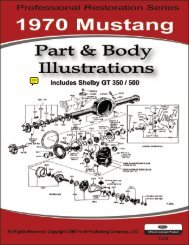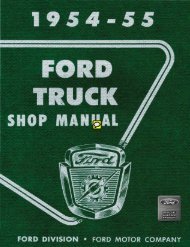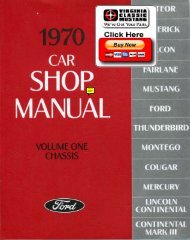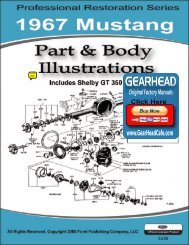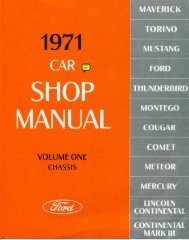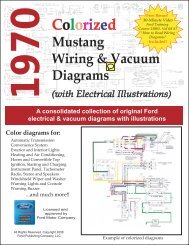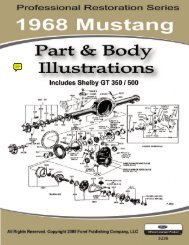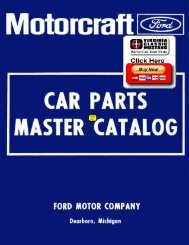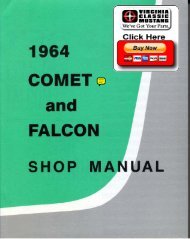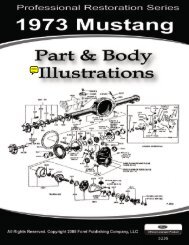DEMO - 1959 Ford Thunderbird Shop Manual - ForelPublishing.com
DEMO - 1959 Ford Thunderbird Shop Manual - ForelPublishing.com
DEMO - 1959 Ford Thunderbird Shop Manual - ForelPublishing.com
You also want an ePaper? Increase the reach of your titles
YUMPU automatically turns print PDFs into web optimized ePapers that Google loves.
'<br />
*<br />
1-48<br />
Section<br />
PART<br />
1-3<br />
THUNDERBIRD 430 SPECIAL<br />
V-8<br />
Page<br />
1 Description 1-48<br />
2 Engine Removal and<br />
Installation 1-52<br />
3 Engine Disassembly (Engine<br />
Removed) 1-54<br />
4 Disassembly and Assembly<br />
of Component Parts 1-56<br />
Section<br />
Page<br />
Valve Rocker Arm Shaft. 1-56<br />
Cylinder Heads 1-56<br />
Hydraulic Valve Lifters . . 1-57<br />
Pistons and Connecting<br />
Rods 1-58<br />
Oil- Vacuum Pump 1-59<br />
Section<br />
Pare<br />
5 Engine Assembly (Engine<br />
Removed) 1-61<br />
6 Repair Operations (Engine<br />
Installed) 1-68<br />
Engine Supports 1-68<br />
Intake Manifold 1-68<br />
Cylinder Heads 1-69<br />
Crankshaft Damper 1-70<br />
Cylinder Front Cover and<br />
Timing Chain 1-70<br />
Camshaft 1-70<br />
Hydraulic Valve Lifter<br />
Replacement 1-71<br />
Flywheel 1-71<br />
Oil Filter Replacement. . . 1-71<br />
Oil Pan and Oil- Vacuum<br />
Pump 1-71<br />
|| DESCRIPTION<br />
The <strong>Thunderbird</strong> 430 Special V-8<br />
engine (Fig. 1) has a 4.30-inch bore<br />
and a 3.70-inch stroke and a total<br />
piston displacement of 430 cubic<br />
inches. It has a <strong>com</strong>pression ratio of<br />
10.0:1. The patent plate symbol for<br />
the engine is "J."<br />
MANIFOLDS<br />
The intake manifold is water heated<br />
to assist in vaporizing the in<strong>com</strong>ing<br />
fuel charge. The water passages are<br />
located beneath the fuel passages.<br />
Refer to "Cooling System" in this sec<br />
tion for a description of the water<br />
circulation through the manifold.<br />
The intake manifold has two sets<br />
of fuel passages, each with its own<br />
separate inlet connection to the car<br />
buretor (Fig. 2). The right side of the<br />
carburetor feeds Nos. 1, 4, 6 and 7<br />
cylinders and the left side feeds Nos.<br />
2, 3, 5,<br />
and 8 cylinders.<br />
CYLINDER HEADS<br />
The cylinder head assemblies con<br />
tain the valves and the valve rocker<br />
arm shaft assembly. Valve guides are<br />
an integral part of the head. The in<br />
take and exhaust valve assemblies are<br />
the rotating-type which rotate each<br />
time the valve opens and closes. The<br />
valve ports (Fig. 3) are water jacketed<br />
and are arranged so that no two ex<br />
haust valves are adjacent. The valves<br />
are arranged from front to rear on the<br />
right bank I-E-I-E-I-E-I-E, and on<br />
the left bank E-I-E-I-E-I-E-I.<br />
CYLINDER BLOCK<br />
The <strong>com</strong>bination oil and vacuum<br />
pump is mounted to the engine block<br />
at the front. The distributor is lo<br />
cated at the front of the engine and<br />
drives the oil pump through an inter<br />
mediate drive shaft.<br />
The <strong>com</strong>bustion chambers are lo<br />
cated in the cylinder block. The<br />
chambers are formed by casting the<br />
top of each bank at a 10 angle with<br />
"<br />
1869-A<br />
_<br />
A<br />
t*MM<br />
Tg<br />
I \ '* \<br />
*<br />
^ '.J<br />
A J,<br />
Cr %T-




